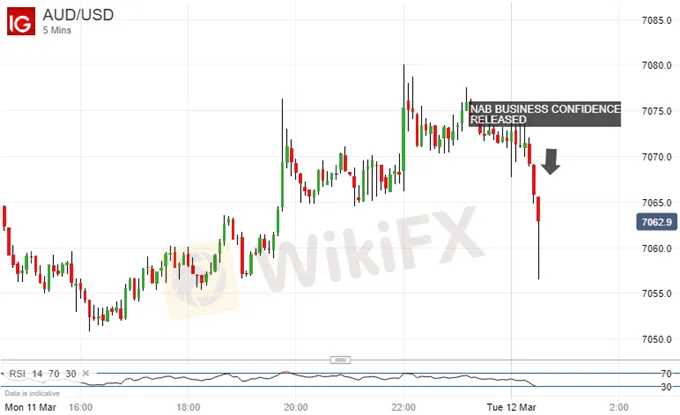简体中文
繁體中文
English
Pусский
日本語
ภาษาไทย
Tiếng Việt
Bahasa Indonesia
Español
हिन्दी
Filippiiniläinen
Français
Deutsch
Português
Türkçe
한국어
العربية
Australian Dollar Wilts As NAB Business Confidence Falls Short
Abstract:The Australian Dollar slid as a key measure of business sentiment registered its weakest level since the start of 2016, adding to peristent disappointments in
Australian Dollar, NAB Business Confidence Talking Points:
Confidence hit a three year low according to NA
Assessments of current conditions were also weaker
The Australian Dollar headed lower, with the market now looking ahead to Wednesdays consumer confidence snapshot
Join our analysts for live, interactive coverage of all major economic data at the DailyFX Webinars. Wed love to have you along.
The Australian Dollar slipped on Tuesday following yet more weak economic data, headlined by weaker business confidence.
The index for that from National Australia Bank came in at 2 for February, below January‘s 4. It was also the lowest print since the start of 2016. Firms’ assessment of current conditions slipped to 4 from 7. Investment lending also fell, dropping 4.1% after its previous 1.5% slide.
AUD/USD unsurprisingly slipped on the news, with focus now likely to settle on consumer confidence numbers which are due for release on Wednesday.

The Australian economy is still a strong creator of jobs despite plenty of weak economic readings elsewhere. The problem for Australian Dollar bulls though is that there seems to be a complete lack of inflationary pressures.
AUD/USD remains stick in a pervasive downtrend channel on its daily chart. The currency is weighed down by expectations that record-low Australian interest rates may yet fall further. The latest disappointing growth figures didn‘t help Aussie bulls’ cause either.

Given all that it is quite hard to get bullish about the currency over the medium-term. However, any signs of a durable trade settlement between China and the US could well see growth-sensitive assets such as the Aussie catch a bid, even if it is more debatable whether such a settlement would be the answer to all global economic worries, as some investors clearly seem to believe.
Disclaimer:
The views in this article only represent the author's personal views, and do not constitute investment advice on this platform. This platform does not guarantee the accuracy, completeness and timeliness of the information in the article, and will not be liable for any loss caused by the use of or reliance on the information in the article.
Read more

Key Economic Calendar Events for This Week (August 5-9, 2024)
This week's economic events include: Japan's Monetary Policy Minutes and U.S. Services PMI on Monday, impacting JPY and USD. Tuesday's RBA Interest Rate Decision affects AUD, with German Factory Orders influencing EUR. Wednesday sees German Industrial Production and U.S. Crude Inventories impacting EUR and USD. Thursday: RBA Governor speaks, with U.S. Jobless Claims. Friday: China's CPI and Canada's Unemployment Rate affect CNY and CAD.

Economic and Political Shifts Impact Global Markets Part 2
Recent developments include President Biden's potential re-election reconsideration, Asia-Pacific market highs, PwC's auditing issues in China, potential acquisitions in the energy and retail sectors, geopolitical tensions, and regulatory actions impacting markets. Key impacts include fluctuations in USD, CNY, CAD, TWD, EUR, GBP, and AUD, with significant effects on stock markets across the US, Asia, and Europe.

Economic and Political Shifts Impact Global Markets Part 1
Recent developments include President Biden's potential re-election reconsideration, Asia-Pacific market highs, PwC's auditing issues in China, potential acquisitions in the energy and retail sectors, geopolitical tensions, and regulatory actions impacting markets. Key impacts include fluctuations in USD, CNY, CAD, TWD, EUR, GBP, and AUD, with significant effects on stock markets across the US, Asia, and Europe.

The Strong NFP Bolsters the Dollar
The U.S. labor market's vigorous expansion, with the Non-Farm Payroll (NFP) report disclosing an impressive 303,000 job additions that exceeded both previous results and projections; bolstering dollar
WikiFX Broker
Latest News
BI Apprehends Japanese Scam Leader in Manila
Bitcoin in 2025: The Opportunities and Challenges Ahead
Join the Event & Level Up Your Forex Journey
Is There Still Opportunity as Gold Reaches 4-Week High?
Bitcoin miner\s claim to recover £600m in Newport tip thrown out
Good News Malaysia: Ready for 5% GDP Growth in 2025!
How to Automate Forex and Crypto Trading for Better Profits
FXCL Lucky Winter Festival Begins
Warning Against MarketsVox
Is the stronger dollar a threat to oil prices?
Currency Calculator






